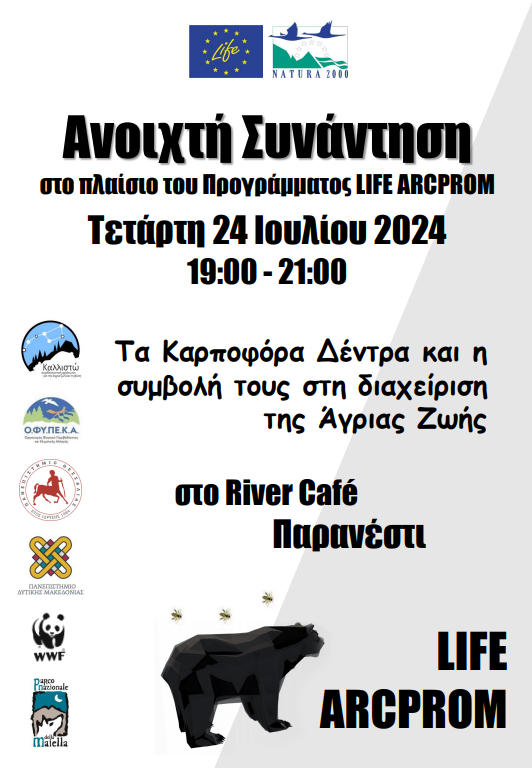Ανοιχτή συνάντηση στο Παρανέστι για τα καρποφόρα δέντρα και τη συμβολή τους στη διαχείριση της άγριας ζωής
Θέμα: Ανοιχτή Συνάντηση με την Τοπική Κοινωνία | «Τα καρποφόρα δέντρα και η συμβολή τους στην διαχείριση της άγριας ζωής»
Ημερομηνία: Τετάρτη, 24 Ιουλίου 2024
Ώρα: 19:00 – 21:00
Τόπος: Καφέ Μπαρ «River Café», Παρανέστι
Πληροφορίες: 2310252530, 2524021030
Ανοιχτή συνάντηση με την τοπική κοινωνία στην περιοχή του Εθνικού Πάρκου Οροσειράς Ροδόπης και με θέμα «Τα Καρποφόρα Δέντρα και η συμβολή τους στη διαχείριση της Άγριας Ζωής» διοργανώνουν η Περιβαλλοντική Οργάνωση Καλλιστώ σε συνεργασία με τη Μονάδα Διαχείρισης Εθνικών Πάρκων Νέστου-Βιστωνίδας και Ροδόπης του ΟΦΥΠΕΚΑ, στο πλαίσιο του ευρωπαϊκού προγράμματος LIFE ARCPROM.
Η συνάντηση θα πραγματοποιηθεί την Τετάρτη 24 Ιουλίου 2024, ώρα 19:00 – 21:00, στο «River Café» στο Παρανέστι, και στοχεύει στην ενημέρωση της τοπικής κοινωνίας σχετικά με καλές πρακτικές για τη βέλτιστη διαχείριση των καρποφόρων δέντρων. Στη συνέχεια, θα πραγματοποιηθεί χαρτογράφηση των εγκαταλελειμμένων καρποφόρων δέντρων και παλιών κοινοτικών οπωρώνων που βρίσκονται στην περιοχή. Θα ακολουθήσει συζήτηση με εκπροσώπους της τοπικής κοινωνίας.
Ο συνδυασμός της κλιματικής κρίσης και της εγκατάλειψης ης ελληνικής υπαίθρου έχουν αφήσει το αποτύπωμά τους στα οικοσυστήματα και στη συμπεριφορά των άγριων ζώων, όπως είναι η καφέ αρκούδα. Οι αρκούδες τρέφονται κυρίως με καρπούς οπωροφόρων δέντρων, στη διάρκεια μιας περιόδου περίπου 6 μηνών κάθε χρόνο, λόγω και της χρονικής αλληλουχίας ωρίμανσης των καρπών. Ωστόσο, ένας συνδυασμός παραγόντων, όπως η κοντινή απόσταση οπωροφόρων από κατοικημένες περιοχές, η κακή διαχείριση των οικιακών απορριμμάτων, καθώς και η πιθανή έλλειψη επαρκούς τροφής στο δάσος, καθώς και άλλοι παράγοντες, όπως η προστασία των νεογνών από τα επιθετικά αρσενικά, μπορεί να τις εξωθήσει στο να αναζητήσουν τροφή πιο κοντά σε ανθρώπινους οικισμούς.
Υπάρχουν πολλοί λόγοι για τους οποίους μία αρκούδα μπορεί να εισέλθει σε έναν οικισμό. Μερικοί από αυτούς σχετίζονται με την απώλεια, κατάτμηση και υποβάθμιση των ενδιαιτημάτων της, την ευκολία ανεύρεσης τροφής σε οικιακά απορρίμματα (κάδοι σκουπιδιών) αλλά και κάποια ιδιαίτερα συμπεριφορικά χαρακτηριστικά των θηλυκών που έχουν μικρά. Η αντιμετώπιση αυτής της πρόκλησης απαιτεί μια πολυδιάστατη προσέγγιση που συνδυάζει την παρακολούθηση και ενδεχόμενη βελτίωση των φυσικών πηγών τροφής και την αποκατάσταση των ενδιαιτημάτων της καφέ αρκούδας, την ενημέρωση των κατοίκων σχετικά με την υιοθέτηση μέτρων προστασίας και πρόληψης ζημιών, και τη συνεργασία διαφορετικών κοινωνικών εταίρων για την υλοποίηση συντονισμένων δράσεων.
Για παράδειγμα, η συντήρηση παλαιών οπωρώνων στην δασική ζώνη βλάστησης και η φύτευση νέων καρποφόρων δέντρων σε ασφαλείς περιοχές, μακριά από οικισμούς, μπορεί να συμβάλει στη βελτίωση της διαθεσιμότητας τροφής και να μειώσει την ανάγκη τους να πλησιάζουν κοντά σε κατοικημένες περιοχές. Παράλληλα, η σωστή φροντίδα και η περίφραξη των οπωροφόρων δέντρων εντός των οικισμών, καθώς και η βέλτιστη διαχείριση των οικιακών απορριμμάτων, μπορούν να συμβάλουν στην αλλαγή της συμπεριφοράς «εξοικείωσης» που παρουσιάζουν μερικές αρκούδες με την ανθρώπινη παρουσία και δραστηριότητα.
Σημειώνεται ότι την επόμενη της ανοιχτής συνάντησης θα πραγματοποιηθεί η 6η συνεδρίαση της «Πλατφόρμας Συνύπαρξης Τοπικών Κοινωνιών-Αρκούδας», η οποία αποτελείται από εκπροσώπους τοπικών φορέων, οργανώσεων και άλλων ενδιαφερομένων μερών που σχετίζονται με την παρουσία της αρκούδας στην περιοχή.
Στη συνεδρίαση θα εξεταστούν μέθοδοι καλύτερης διαχείρισης των καρποφόρων δέντρων στο Εθνικό Πάρκο καθώς και ενθάρρυνσης της αποκατάστασης εγκαταλελειμμένων οπωρώνων και τη φύτευση νέων οπωρώνων και οπωροφόρων θάμνων.







